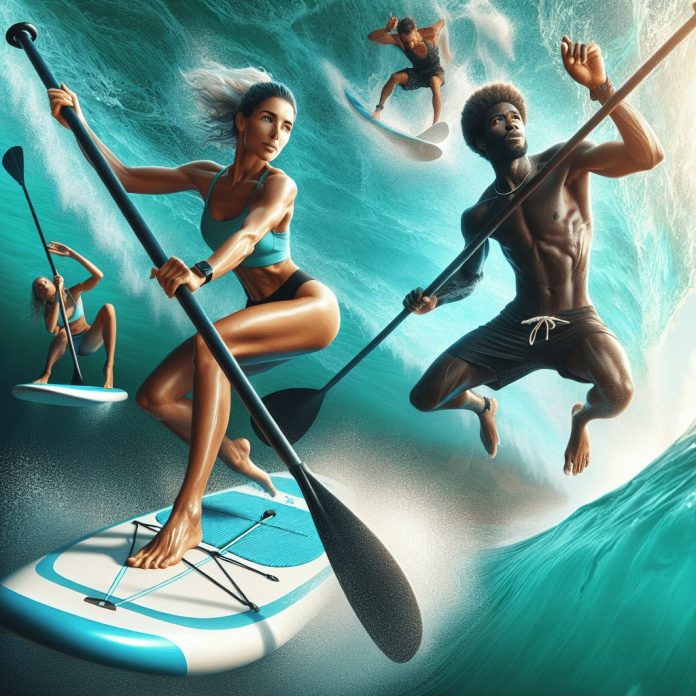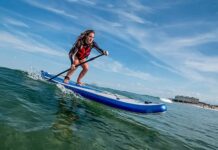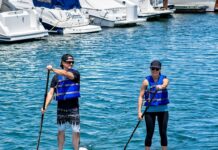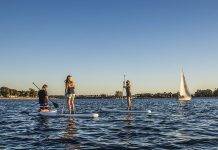In the exhilarating world of stand-up paddleboarding (SUP), finding balance on the board is of utmost importance. However, even experienced paddlers may find themselves taking an unexpected plunge into the refreshing waters. In this article, we uncover the common factors that contribute to those surprising falls off SUP boards. From unstable conditions to a misplaced center of gravity, we explore the reasons behind these tumbles and provide practical tips to help you stay upright and enjoy your paddleboarding adventures to the fullest.
Balance and Body Position
Improper stance
Maintaining the proper stance and balance is crucial when paddleboarding. Failing to position ourselves correctly on the board can easily lead to falls. It’s essential to keep our feet shoulder-width apart and parallel to the stringer, which is the central line of the board. By doing so, we can distribute our weight evenly and maintain stability.
Poor weight distribution
Another factor that can cause falls is poor weight distribution. If we put too much weight on our toes or heels, it can throw off our balance and increase the likelihood of losing control. The key is to distribute our weight evenly between the front and back of the board, as well as keeping our weight centered to maintain stability.
Incorrect body position
Maintaining the right body position while paddleboarding is vital for stability and control. Leaning too far forward or backward can make it challenging to maintain balance and increase the risk of falling off. It’s important to keep our back straight, slightly bend our knees, and engage our core muscles. This posture helps us absorb any bumps or waves and improves our overall balance on the board.
Environmental Factors
Choppy or rough water conditions
Choppy or rough water conditions can significantly impact our stability on a SUP board. When faced with waves or turbulent waters, it requires a higher level of skill and balance to stay upright. The unpredictable nature of the water’s surface can make it harder to maintain control and increase the chances of falling.
Strong winds and gusts
Strong winds and gusts can greatly affect our stability while paddleboarding. Wind can create lateral forces on the board, making it harder to maintain a straight course and balance. To counteract this, we must adjust our stance and paddle technique to compensate for the wind’s force. Failing to do so can result in falls or being blown off course.
Crosswinds and side currents
Crosswinds and side currents can make paddleboarding more challenging, especially for beginners. When faced with a crosswind or side current, it can push us off course and affect our balance. Learning to anticipate and adjust to these external factors is crucial in maintaining stability and preventing falls.
Intense waves and whitewater
Intense waves and whitewater can be exhilarating, but they also pose a greater risk of falling off a SUP board. These conditions require advanced paddleboarding skills and experience to navigate successfully. It’s important to read the waves, choose the right line, and adjust our body position accordingly. Failing to do so can result in losing balance and being knocked off the board by the force of the waves.
Presence of obstacles (rocks, reefs, buoys)
The presence of obstacles such as rocks, reefs, and buoys can pose a significant hazard when paddleboarding. These obstacles can disrupt the flow of the water and create unpredictable currents. Failing to navigate around these obstacles or misjudging their distance can result in collisions and falls. It’s essential to be aware of our surroundings and exercise caution to avoid potential accidents.
Equipment Related
Inadequate SUP board size or stability
Using an inadequate SUP board size or stability can increase the risk of falling off. A board that is too small or lacks stability can be more challenging to balance on, especially for beginners. It’s important to choose a board that suits our skill level, weight, and intended use. Selecting the right board ensures better stability and decreases the chances of falling.
Damaged or poorly maintained SUP board
A damaged or poorly maintained SUP board can compromise its performance and stability, increasing the chances of falling off. Cracks, dents, or loose fins can affect the board’s structural integrity and make it less reliable on the water. Regular inspections and maintenance are essential to ensure our boards are in optimal condition and safe to use.
Inappropriate paddle length or grip
Using an inappropriate paddle length or grip can negatively impact our balance and control while paddleboarding. A paddle that is too long or too short can throw off our rhythm and compromise our stability. Likewise, a grip that doesn’t suit our hand size or paddling technique can cause discomfort and affect our control. It’s crucial to choose a paddle that suits our individual needs and preferences to maximize stability and prevent falls.
Wrong choice of fins
Fins play a critical role in stabilizing and maneuvering a SUP board. Using the wrong type or size of fins can affect our board’s stability and control. Larger fins provide more stability, but they can also create drag, making it harder to paddle. Smaller fins offer better maneuverability, but they may compromise stability in rough water conditions. Understanding the different types of fins and selecting the right ones for our needs can greatly enhance our paddleboarding experience and reduce the risk of falling.
Inexperience and Lack of Skill
Insufficient practice and training
Lack of practice and training can significantly increase the likelihood of falling off a SUP board. Paddleboarding requires a combination of balance, coordination, and strength, which can only be developed through regular practice. Without sufficient practice and training, it becomes difficult to maintain stability and control, making falls more common.
Inability to maneuver the board
Being unable to maneuver the board effectively can lead to falls, especially in challenging water conditions. Paddleboarding involves turning, pivoting, and adjusting our course based on the environment and obstacles. Without the necessary skill and technique, it becomes harder to maintain balance and avoid falling off.
Lack of paddle technique
Proper paddle technique is essential for maintaining balance and control on a SUP board. Inefficient or incorrect paddle strokes can throw off our balance and increase the chances of falling. It’s important to learn and practice the correct paddle technique, including using the full blade, engaging the core, and maintaining a smooth and rhythmic stroke. Developing a solid paddle technique enhances our stability and reduces the risk of falls.
Difficulty in maintaining balance
Some individuals may naturally struggle to maintain balance on a SUP board due to factors such as height, weight distribution, or physical limitations. While balance can be improved with practice, some individuals may face additional challenges. For those with difficulty maintaining balance, using wider and more stable boards and seeking professional guidance can be beneficial in reducing the risk of falling.
Water Conditions and Hazards
Presence of strong currents
Strong currents can pose a significant risk to paddleboarders, especially in areas with tidal changes or river currents. These currents can make it harder to maintain stability and control. Being aware of the local current patterns, planning our route accordingly, and keeping a safe distance from areas with strong currents can help mitigate the risk of falls.
Undertows and rip currents
Undertows and rip currents are powerful, narrow currents that flow away from the shore and can pull paddleboarders out to sea. Falling into an undertow or rip current can make it extremely difficult to paddle back to shore and increase the risk of a dangerous situation. It’s essential to understand the signs of these currents, avoid them, and seek assistance if caught in one.
Cold water temperature affecting muscle control
Cold water temperature can affect our muscle control and increase the risk of falling off a SUP board. When exposed to cold water for an extended period, our muscles may become less responsive, reducing our ability to maintain stability and control. Wearing appropriate wetsuits or drysuits, staying adequately hydrated, and knowing our limits in cold water conditions can help mitigate this risk.
Intrusion of marine life (jellyfish, sharks, etc.)
The presence of marine life, such as jellyfish or sharks, can startle and distract paddleboarders, potentially leading to falls. While encounters with marine life are rare, it’s important to be aware of the local wildlife and take necessary precautions. Taking extra care when paddling in areas known for marine life, such as wearing protective gear and avoiding known feeding grounds, can decrease the risk of accidents.
Sudden changes in tides
Sudden changes in tides can catch paddleboarders off guard and increase the risk of falling. Rapidly rising or receding water levels can create strong currents or expose shallow areas. Before engaging in paddleboarding in coastal areas, it’s crucial to familiarize ourselves with the local tide tables and plan our activities accordingly. Being aware of the changing tides allows us to make informed decisions and reduces the likelihood of falling due to unexpected water conditions.
Distractions and External Factors
Lack of focus and attention
Lack of focus and attention can contribute to falls while paddleboarding. Engaging in distracting activities or thoughts while on the board can compromise our ability to maintain balance and react to changes in the environment. It’s important to prioritize safety and remain fully present while paddleboarding to mitigate the risk of accidents.
Distraction by other water activities
Paddleboarding often takes place in busy waterways with various water activities happening simultaneously. Being distracted by other water activities can lead to falls. It’s crucial to stay vigilant and pay attention to our surroundings, especially when sharing the water with boats, jet skis, or other paddleboarders. Being mindful of the potential risks posed by other water activities allows us to navigate safely and prevent accidents.
Noise or unfamiliar surroundings
Loud noises or unfamiliar surroundings can startle and distract paddleboarders, increasing the likelihood of falling off. Unexpected noises, such as loud boat engines or nearby construction, can disrupt our focus and stability. Paddleboarding in unfamiliar areas with hidden hazards can also create distractions and cause falls. To minimize these risks, choosing quieter locations and gradually exploring new areas can help maintain focus and reduce distractions.
Sun glare or poor visibility
Sun glare and poor visibility can affect our ability to maintain stability and avoid hazards. Glare from the sun bouncing off the water can make it harder to see the surface of the water clearly, increasing the risk of unexpected bumps or obstacles. Additionally, poor visibility due to fog, rain, or darkness can make navigation challenging and increase the chance of falls. Wearing polarized sunglasses, choosing paddleboarding times with better lighting conditions, and avoiding areas with limited visibility can help mitigate these risks.
Physical Fitness and Fatigue
Weak core muscles
Having weak core muscles can make it harder to maintain balance on a SUP board. The core muscles play a crucial role in stabilizing our body while paddleboarding. If our core muscles are weak, it becomes more challenging to maintain proper posture and balance, increasing the risk of falls. Regular core strengthening exercises, such as planks and yoga, can improve our stability on the board and reduce the likelihood of falling.
Insufficient strength and endurance
Insufficient overall strength and endurance can compromise our ability to paddle effectively and maintain balance. Paddleboarding requires the engagement of various muscle groups, including the arms, shoulders, and back. If we lack the necessary strength and endurance, it becomes harder to paddle for extended periods and maintain stability. Incorporating cardiovascular and strength training exercises into our fitness routine can enhance our overall physical fitness and reduce the risk of falls.
Muscle fatigue and cramps
Muscle fatigue and cramps can occur during or after prolonged paddleboarding sessions, increasing the chances of falling off the board. Pushing our muscles beyond their limits or inadequate hydration can lead to muscle fatigue and cramping. Staying properly hydrated, taking breaks when needed, and ensuring adequate rest and recovery can help prevent muscle fatigue and cramps, reducing the risk of falls.
Improper Recovery Techniques
Incorrect technique while falling
Knowing how to fall safely and recover from a fall is essential in minimizing the risk of injury and falling off a SUP board. Attempting to grab the board during a fall can result in collisions or entanglement with the board’s leash. Instead, it’s important to focus on falling away from the board while protecting our head and face. Learning and practicing proper falling techniques can help reduce the impact of falls and avoid potential injuries.
Inability to re-mount the SUP board efficiently
After falling off a SUP board, it’s necessary to remount the board efficiently to continue paddling. Failing to do so can delay our return to stability and increase the risk of additional falls. Knowing different re-entry techniques, such as the belly flop or the Eskimo roll, and practicing them beforehand can improve our ability to remount the board quickly and safely.
Lack of Safety Precautions
Absence of leash or leash failure
Not wearing a leash or experiencing leash failure can result in losing our SUP board and falling into the water. A leash tethers us to the board, preventing it from drifting away if we fall off. It’s crucial to wear a properly attached leash and regularly inspect it for any signs of wear or damage. Ensuring the leash is in good condition and securely fastened reduces the likelihood of losing our board and falling.
Not wearing a personal flotation device (PFD)
Although not mandatory in all areas, wearing a personal flotation device (PFD) can greatly enhance our safety while paddleboarding. A PFD provides buoyancy and ensures we stay afloat in the event of a fall or fatigue. It’s essential to choose a PFD that fits properly and is approved for paddleboarding. Wearing a PFD can provide peace of mind and increase our chances of staying afloat while in the water.
Insufficient knowledge of rescue techniques
Having insufficient knowledge of rescue techniques can amplify the risks associated with falling off a SUP board. Knowing how to assist others or request help in case of an emergency is crucial for our safety and the safety of others. Educating ourselves on proper rescue techniques, such as towing techniques or using a throw bag, can help ensure a swift and effective response in case of an accident.
External Interference
Collisions with other watercraft or objects
Collisions with other watercraft or objects can cause falls and potential injuries while paddleboarding. Sharing the water with boats, jet skis, or other paddleboarders requires vigilance and adherence to boating rules and regulations. Avoiding congested areas, giving way to other watercraft, and maintaining a safe distance from objects can help prevent collisions and falls.
Interference from wildlife or marine animals
Encounters with wildlife or marine animals can startle and distract paddleboarders, leading to falls. While such encounters are typically rare, it’s important to respect the natural environment and give wildlife a wide berth. Avoiding known feeding areas or nesting sites and being mindful of the local wildlife can help minimize the risk of interference and reduce the likelihood of falls.
Paddleboarding offers a fantastic opportunity to explore the water, enjoy nature, and stay active. However, it’s important to be aware of the various factors that can increase the risk of falling off a SUP board. By understanding and addressing these factors, such as maintaining proper balance, being mindful of environmental conditions, using appropriate equipment, and practicing safety precautions, we can enhance our paddleboarding experience while minimizing the chances of falls and injuries. Remember, paddleboarding can be a safe and enjoyable activity when approached with care and consideration for our own safety and that of others. So grab your SUP board, paddle responsibly, and have fun out on the water!





































